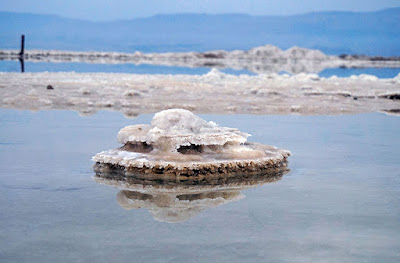One of Israel's desalination plants produces more water than required for urban use, and half of it is funneled to agriculture.
Scientists have discovered that desalinated water's low mineral content, once believed to be an advantage, is bad for crops. Desalinated water is void of any minerals whatsoever, minerals that are critical for the growth of fruits of vegetables. Calcium shortage, for example, causes physiological defects, while magnesium shortage damages the plant's development. If the crops are grown in sand or off the ground, the damage is even worse, because the soil cannot provide the missing elements.
In turn, human beings consuming these plant products get less magnesium in their food. Magnesium is a crucial mineral, deficiency in which may lead to medical problems, including heart attacks.
The Israeli government is obligated by contract to sell, so the state prefers that farmers buy expensive desalinated water. The fact that no crops will thrive in desalinated water if its mineral content is not replenished, doesn’t always interest government officials.
Brackish water is water that has more salinity than fresh water, but not as much as seawater. Although Israel’s Negev Desert lacks any major freshwater sources, there are a number of underground brackish water aquifers whose water is accessible by drilling. Studies conducted at Israel have turned farming with brackish water into an essential component of agriculture in this arid region.
Direct irrigation with brackish water has been successfully pioneered for those crops that can thrive on its special qualities, for example olive tree groves. Barnea is the name of a type of olive developed by local scientists that actually loves brackish water.
Another way brackish water can be used is by mixing a minimum of 15% of brackish water with desalinated water. Essential minerals such as sulfur, magnesium and calcium are reinstated, and the newly-created “cocktail” is perfect for growing various crops. Different crops like different combinations of brackish and sweet water – for example, just before becoming ripe for picking, cherry tomatoes like 60% brackish water and 40% fresh water. Brackish water makes the cherry tomatoes tastier, smaller and also increases the percentage of antioxidants.
 |
| Field in Israel / Natalinasser / CC-BY-SA 4.0 |
In turn, human beings consuming these plant products get less magnesium in their food. Magnesium is a crucial mineral, deficiency in which may lead to medical problems, including heart attacks.
The Israeli government is obligated by contract to sell, so the state prefers that farmers buy expensive desalinated water. The fact that no crops will thrive in desalinated water if its mineral content is not replenished, doesn’t always interest government officials.
 |
| Chilika Lake, India's largest lake, classified as brackish waterbody / gppande / CA-BY-SA 3.0 |
Direct irrigation with brackish water has been successfully pioneered for those crops that can thrive on its special qualities, for example olive tree groves. Barnea is the name of a type of olive developed by local scientists that actually loves brackish water.
Another way brackish water can be used is by mixing a minimum of 15% of brackish water with desalinated water. Essential minerals such as sulfur, magnesium and calcium are reinstated, and the newly-created “cocktail” is perfect for growing various crops. Different crops like different combinations of brackish and sweet water – for example, just before becoming ripe for picking, cherry tomatoes like 60% brackish water and 40% fresh water. Brackish water makes the cherry tomatoes tastier, smaller and also increases the percentage of antioxidants.
























